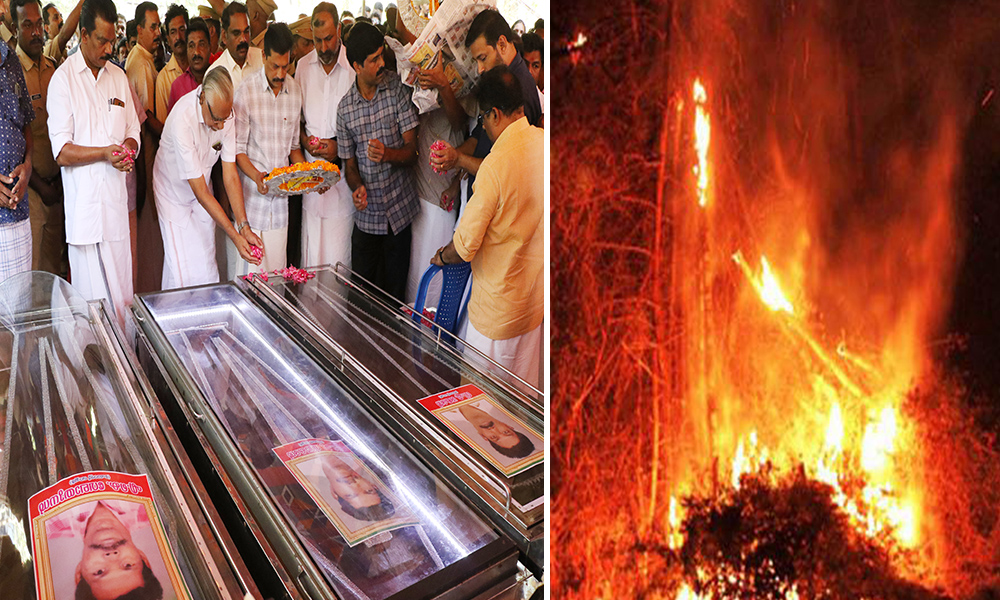
No Equipment, No Training, Low Pay: Facing Death Is Livelihood For These Kerala Forest Fire Fighters
20 Feb 2020 12:41 PM GMT | Updated 24 Aug 2020 10:35 AM GMT
Creatives : Abhishek M |
" An engineer by profession, Abhishek is the creative producer of the team, graphic designing is his passion and travelling his get away. In more ways than one, he makes the content visually appealing."
Beat forest officer, N Noushad, who had a providential escape from the massive fire, managed to rescue a forest guard badly injured in the fire, NP Achu, but failed to trace the three others killed in the incident.
Thrissur (Kerala): For the temporary guards and watchers who constitute the lowest rung on the ladder of official forest management hierarchy, summers are the worst phase in their not so attractive career. There would be a spurt in wildfires by the beginning of February each year and dousing the fires in the blazing sun involves a lot of challenges.
Most of the terrains would remain inaccessible and getting a gulp of drinking water in the middle of the fire fighting stands as a matter of sheer luck. By the time the fires getting doused, they would be summoned for other emergencies like chasing out crop-raiding wild elephants from agricultural fields. To them, the assignments are always risky.
The wildfire tragedy in which three tribal forest watchers were charred to death at Kottambathur near Desamangalam in Kerala's Thrissur district on Sunday afternoon has once again brought into focus the plight of these frontline forest field staff who take enormous risks in protecting the country's rich flora and fauna.
"I spoke to him around 11.30 am on Sunday over the phone. He inquired about me and our four-year-old son Dhyan, who was born after nine years of waiting. It was about two weeks ago, he visited us at home. After that, he was busy with fighting wildfires. Before winding up the call, he said he was about to climb a hill region to douse forest fires. The very next morning, I saw his dead body in the local hospital," said tribal woman Indira, wife of charred forest guard KU Divakaran, struggling hard to contain her emotions. Hailing from a tribal colony inside the famous Parambikulam Tiger Reserve, it was only recently that he constructed a house at Vazhachal near Thrissur and shifted his family there.
Beat forest officer, N Noushad, who had a providential escape from the massive fire, looked still in the grip of the rude shock. He managed to rescue a forest guard badly injured in the fire, NP Achu, but failed to trace the three others killed in the incident.
According to Kerala's Forest Minister, K Raju, the Kottambathur incident was the 99th among forest fires that took place in the state since January 1. Fifteen among them occurred in the last seven days and most of the forest areas of the state are now reeling under a cruel and blistering summer.
In Kottambathur, the tragedy had occurred in a forest area leased out to public sector Hindustan Newsprint Limited (HNL) to grow trees of its choice as raw material, mainly acacia. As the company remains locked out, the plantation remained in an abandoned state with a lot of thick dry wild grass. As the plantation was located in an isolated area, the fire outbreak remained unnoticed in the beginning. The senior officials were not vigilant even though a similar massive wildfire occurred on January 30 last year, inside the same plantation, causing widespread destruction. All the three deceased were poor and under-educated local tribals who formed part of a 30 member team assigned with the task of dousing the fire from around noon on Sunday.
"All the three deceased begun their work after reaching my forest fringe house and quenching their thirst. Among them, Sankaran seemed worried as there was nobody at home to take care of his two school-going kids. His wife was away attending a funeral and the emergency situation would not allow him to reach home in time. I tried to contact them over cell-phone when the fires started engulfing the whole region. But there was no response," said a local farmer, K Sudheesh.
K Sankaran had a small grocery store before being selected as temporary staff by the forest department five years ago. He sold the shop and joined the team. His friend and neighbour KV Velayudhan, a coolie worker, too joined the team around the same period. Both Sankaran and Velayudhan used a common two-wheeler to reach the office from home and the way back. Both Sankaran and Velayudhan had fallen victims to the forest fires. Kerala government has announced an interim compensation of ₹7.5 lakhs each to the families of the dead. A decision on giving a permanent job to a dependent of each of the deceased would be taken after discussions at various official levels.
Though forest officials and researchers have confirmed over the years that the fires which engulf the forests every summer are not spontaneous and they all are manmade, no Indian state is adopting scientific measures to douse the fires and to mitigate the damages including the irreplaceable loss of lives of the poor and underprivileged firefighters. On almost all occasions, the victims of the wildfire tragedies are temporary forest protective staff constituting mainly of the economically and socially weak youngsters of the local forest fringe tribal colonies.
"They are doing a tough job involving high risk. But they continue to remain as a bunch of poorly paid, under-equipped, untrained and often demotivated workforce. Other than fighting wildfires, they have to undertake a number of functions including policing, afforestation and conservation," points out Kerala's leading environmental activist, N Badusha.
As temporary hands, they suffer a lot. Their salary is neither fixed nor assured. Even the meagre remunerations get delayed for several months. They are ineligible for any leave. They have no weekly holidays. Most of them even lack even a decent pair of uniform. Other than worn-out sandals and torn uniforms, what distinguishes these people are the machetes they get from the department. Their salary starts at ₹20,000 per month. In the last two years, more than 500 temporary guards and watchers in Kerala quit the job due to adverse working conditions and huge risks involved.
During peak summer months, forest watchers and guards have to work for several weeks continuously without a break and that too in difficult terrains. Their long-pending demand for a shift system is also remaining unaddressed.
Their families often have to fend for themselves as it is difficult to communicate with the watchers as they work in deep forests where the mobile signal strength is usually very weak or nil. Besides the threat of wild animals, their lives are at risk as they have to deal with wildlife poachers and loggers.
Comparing with other states, Kerala witnesses a large number of wildfires each summer. As per statistics available with Forest Survey of India (FSI), Kerala witnessed 38 incidents of large fires in 2019 alone. In 2018, the total number of such incidents was 314, a significant drop from 716 reported in 2017. Kerala lost 1,114 hectares of forest to fires in 2018 and the financial loss was pegged at ₹53,100.
"It is high time the state will have to appoint an expert committee to assess the loss due to forest fires and build the capacity of the force to fight fires. The issues confronting the temporary staff must be addressed with high priority. District administrations, disaster management authorities and the three-tier panchayats are required to come together to fight the threat posed by fires," said Badusha.
In Kottambathur, the guards with elementary education and very little exposure to forest fire management got caught into flames while they attempted to douse the fire which started engulfing the monoculture plantation at around 12 noon on Sunday. The deceased were identified as P Divakaran, Velayudhan and K Shankaran and they all were underprivileged tribal youths of the locality. Meanwhile, forest range officer CR Ranjith managed to escape with minor injuries.
According to Kerala's Chief Forest Conservation Officer, PK Kesavan, the sudden hike in temperature might have contributed to the severity of the tragedy, presumably a handiwork of anti-social elements. "Since January middle, mercury was raising steadily in Kerala with temperature going up by 2-4°C. On Sunday, Thrissur's neighbouring Palakkad had recorded 38°C, which is unusual for the month of February,'' he said.
Going by statistics, this was not the first time that temporary forest guards turned victims to forest fires. Exactly about two years ago, two such people were burnt to death at Pulpally in Wayanad while attempting to combat the fires. Three years ago, another guard was charred to death at Kulathoopuzha forests in Kollam district. Similar incidents have been reported from Mudumala in Andhra Pradesh, Sathyamangalam tiger reserve in Tamil Nadu, Bandipur and Nagerhole national parks in Karnataka. But all these instances remained underreported. In 2018, 23 people, mostly trekkers, were burnt to death in a massive forest fire in Kurangani hills along Tamil Nadu-Kerala borders near Idukki, bringing the issue to nationwide attention. Only when such a large number of tourists were killed, the national focus was centred on this issue.
Strangely, these incidents are happening at a time when the Kerala government is claiming that its forest conservation and afforestation campaigns are yielding huge dividends and the forest cover in the State continues to increase even during the second consecutive assessment period. During December last, Kerala was ranked third among the top five states in terms of increase in forest cover by the India State of Forest Report, 2019, prepared by Forest Survey of India of the Ministry of Environment, Forests and Climate Change. As per the report, forest cover in Kerala was found to have gone up by 823 sq km against the last assessment held in 2017.
According to an environmental lawyer and activist, Harish Vasudevan, Kerala is simply following the British introduced system of controlled burning of undergrowth in safe winter season to avoid forest fires in summer. As a result, there would be nothing left to be burnt in the peak summer months. This is a destructive practice as it reduces minor reptiles, seeds, herbs and bushes to ashes, he says. In the case of the leased out monoculture land in Thrissur, even the controlled burning had not happened this time. There was a total lack of preparedness this time. The dried up under vegetations were not cleared. No fire lines were made. Like in all other parts of the state, the Desamangalam forest office has a severe shortage of protective staff. The actual number of Forest Department personnel trained in fire fighting was abysmally nil.
Even in well-protected tiger reserves of South India, the only facility available to fight forest fires is a few jeeps that can carry the temporary guards. There is a need to increase the number of trained firefighters and to equip them with all required facilities including bottled drinking water, back-up supplies of food, proper boots and other implements. These people also must be paid better. Local tribals are the best available manpower but they must be made permanent in service and their financial needs also must be addressed. Well-equipped and well-trained forest protective staffs are the need of the hour.
According to experts, forest fires depend on a number of environmental factors and they include previous years' rainfall pattern, monsoon withdrawal, humidity and temperature during the fire season. Accumulation of biomass, combined with high winds, increases the impact of forest fires. Causing forest fires is illegal under the Indian Forest Act of 1927 and the Wildlife (Protection) Act of 1972 but there is a visible lack of information on it even among traditional forest-dwelling communities. Fire lines are an answer but not foolproof.
In March 2019, a major fire broke out in Vattavada near famous tourism location Munnar despite spending several lakhs on fire lines. Many forest areas in Pazhathottam, Jandamala, Kadavari and Anamala were reduced to ashes in that fire. Over thousand hectares were lost. In most forest areas of Kerala, increasing number of human-wildlife conflicts are also contributing to the wildfires.
• Kerala lost 1,114 hectares of forest to fires in 2018 and the financial loss was pegged at ₹53,100.
• Causing forest fires is illegal under the Indian Forest Act of 1927 and the Wildlife (Protection) Act of 1972.
• Forest fires depend on a number of environmental factors and they include previous years' rainfall pattern, monsoon withdrawal, humidity and temperature during the fire season.
• Accumulation of biomass, combined with high winds, increases the impact of forest fires.
• Increasing number of human-wildlife conflicts are also contributing to the wildfires.
 All section
All section














